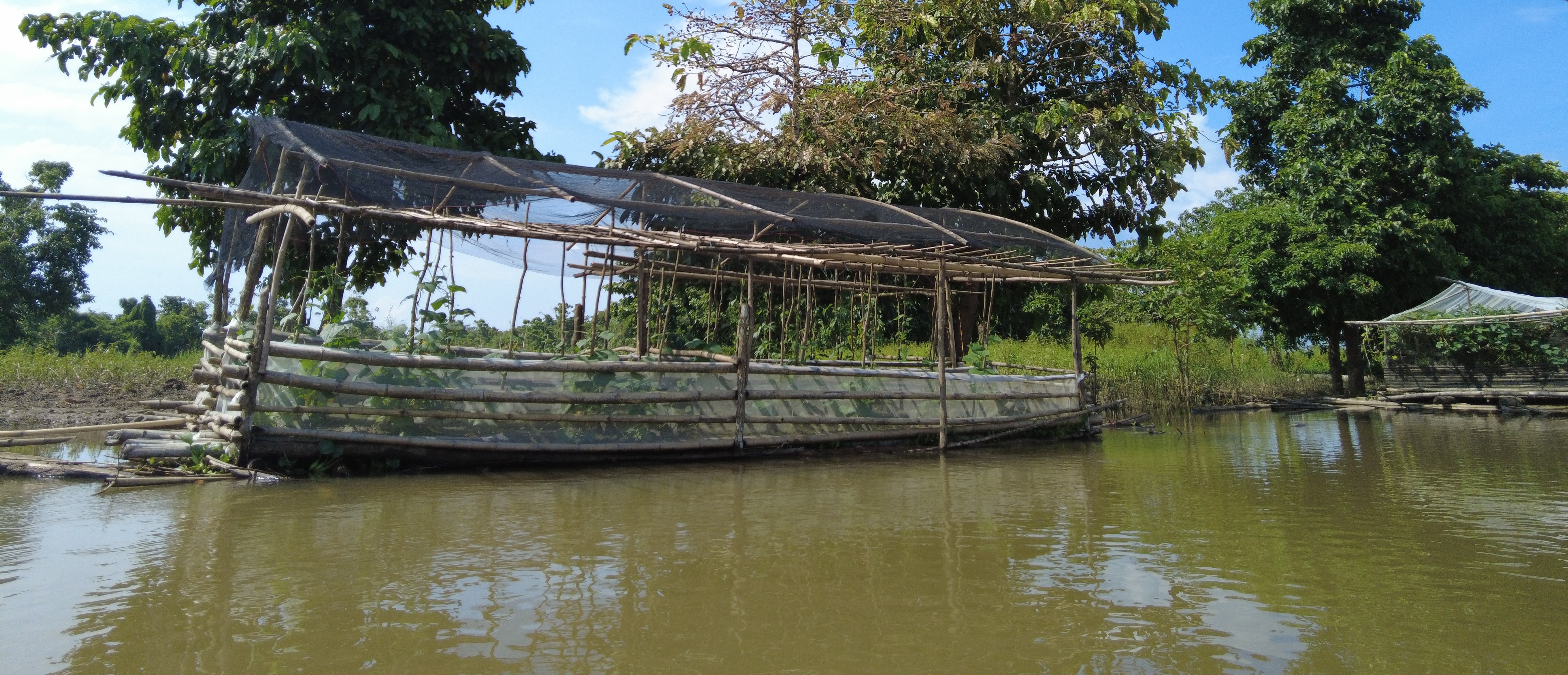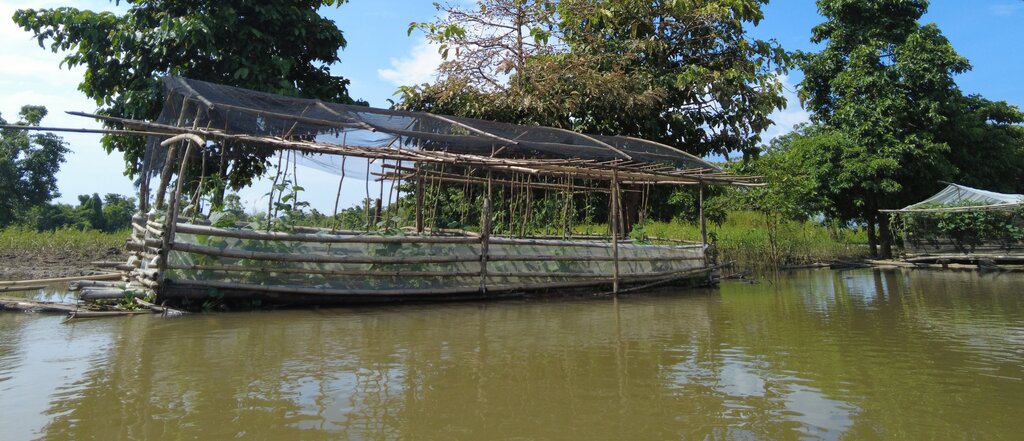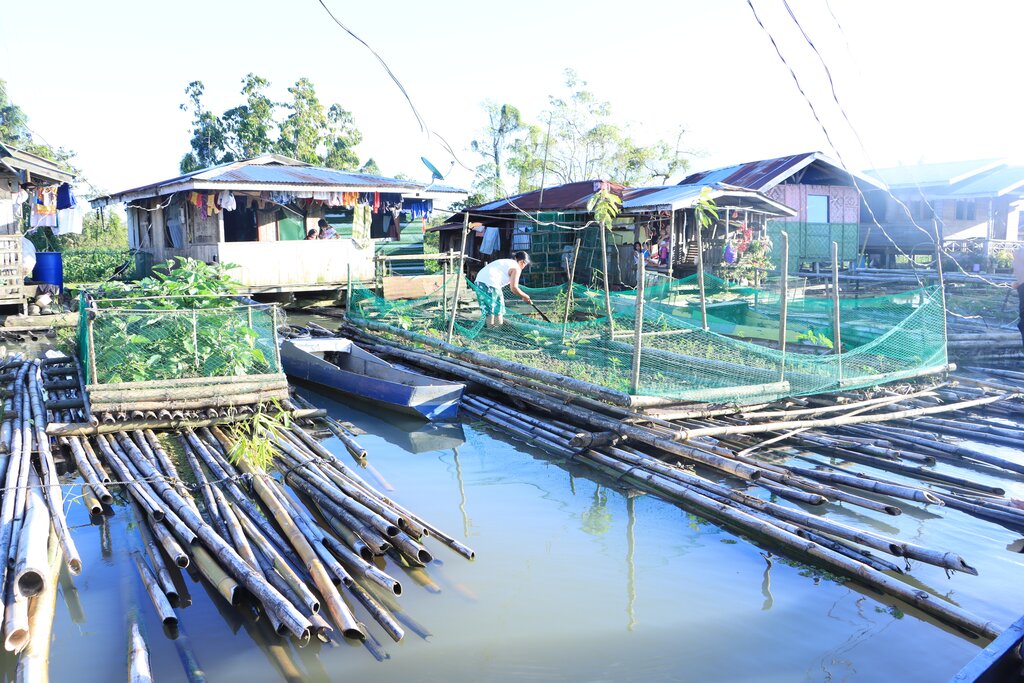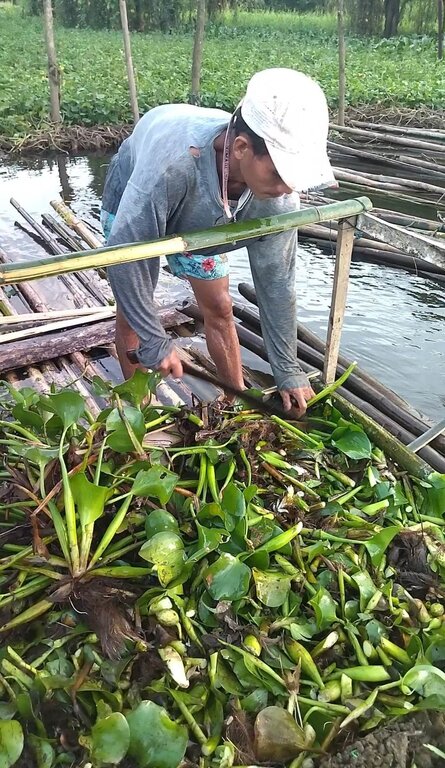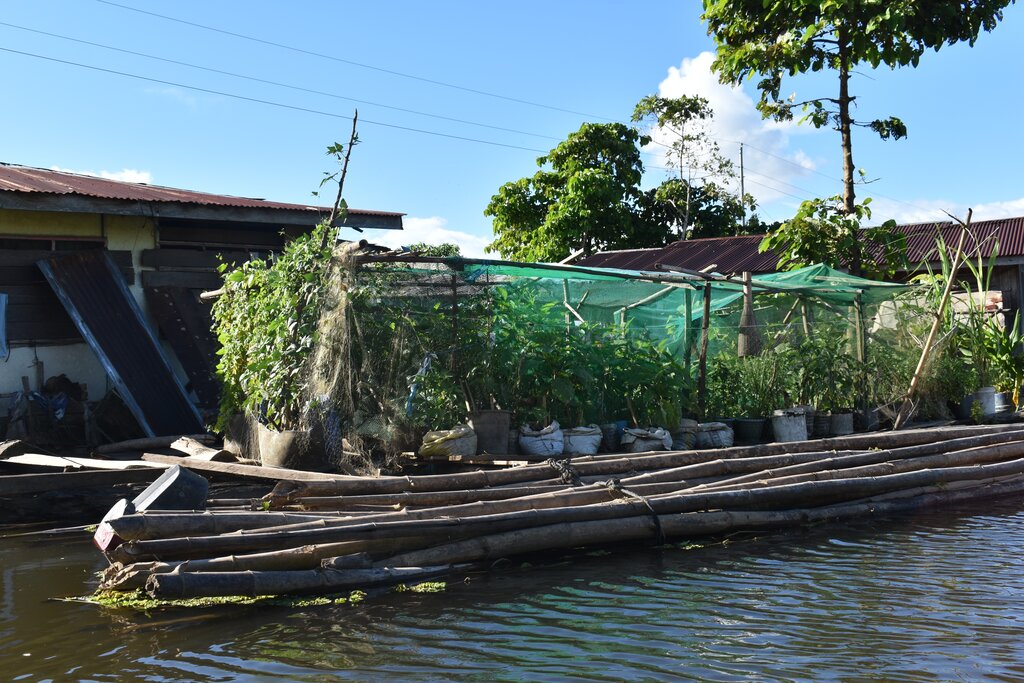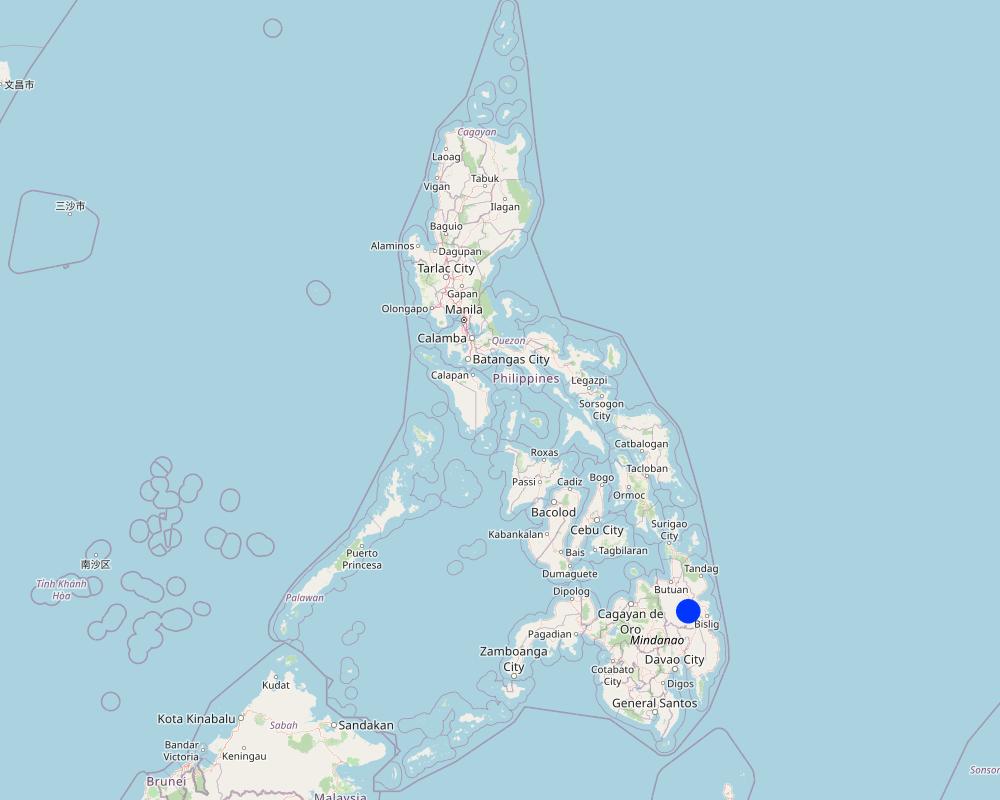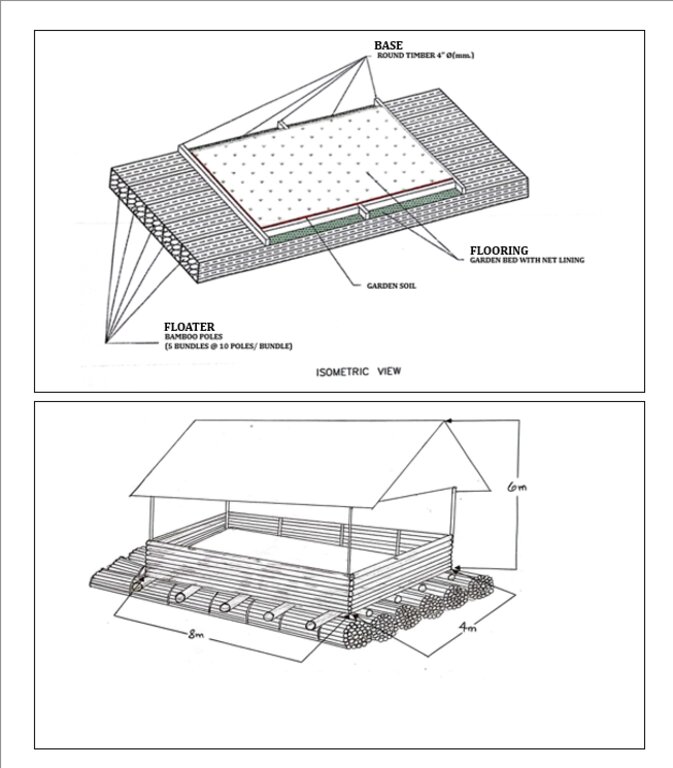Floating Vegetable Garden Using Water Hyacinth as Planting Medium [Philippines]
- Creation:
- Update:
- Compiler: Philippine Overview of Conservation Approaches and Technologies
- Editor: –
- Reviewer: Rima Mekdaschi Studer
Gulayan sa Gakit
technologies_7000 - Philippines
View sections
Expand all Collapse all1. General information
1.2 Contact details of resource persons and institutions involved in the assessment and documentation of the Technology
Key resource person(s)
land user:
Perez Mercy
Barangay Sabang Gibong, Talacogon, Agusan del Sur
Philippines
land user:
Cutao Arnel
Barangay Sabang Gibong, Talacogon, Agusan del Sur
Philippines
land user:
Osigan Marvin
Barangay Sabang Gibong, Talacogon, Agusan del Sur
Philippines
Project Implementer:
Acopiado Ma. Angelita Salome
Agusan del Sur Provincial Environment and Natural Resources Office (PENRO)
Philippines
Project Implementer:
Dumaguit Dennis
LGU of Talacogon, Agusan del Sur
Philippines
Project Implementer:
Asufre Gemma
Department of Agriculture CARAGA
Philippines
Project Implementer:
Tabudlong Richard
Department of Agriculture CARAGA
Philippines
co-compiler:
Dinamling Djolly Ma
Bureau of Soils and Water Management
Philippines
Biodiversity Corridor Project staff who facilitated the interviews:
Plaza Marvin Emmanuel
Bureau of Soils and Water Management
Philippines
Biodiversity Corridor Project staff who facilitated the interviews:
Talavera Ana Marie
Bureau of Soils and Water Management
Philippines
Biodiversity Corridor Project staff who facilitated the interviews:
Manuel Paquito Jr.
Bureau of Soils and Water Management
Philippines
Biodiversity Corridor Project staff who facilitated the interviews:
Barraca Jodel
Bureau of Soils and Water Management
Philippines
Project Implementer:
Amante Romer
Department of Agriculture CARAGA
Philippines
Name of project which facilitated the documentation/ evaluation of the Technology (if relevant)
Integrated Approach in Management of Major Biodiversity Corridors in the Philippines - GEF 6 Project (BD corridor)Name of the institution(s) which facilitated the documentation/ evaluation of the Technology (if relevant)
Bureau of Soils and Water Management (Bureau of Soils and Water Management) - Philippines1.3 Conditions regarding the use of data documented through WOCAT
The compiler and key resource person(s) accept the conditions regarding the use of data documented through WOCAT:
Yes
1.4 Declaration on sustainability of the described Technology
Is the Technology described here problematic with regard to land degradation, so that it cannot be declared a sustainable land management technology?
No
2. Description of the SLM Technology
2.1 Short description of the Technology
Definition of the Technology:
Floating vegetable garden as a climate change adaptation strategy for the indigenous communities living in the wetland of Agusan del Sur to grow vegetables during the flooding season.
2.2 Detailed description of the Technology
Description:
Agusan Marsh is considered one of the wetlands in the Philippines that experiences flooding all year round, and most areas are flooded, making it impossible to grow food for the communities living in the area. In order to address this issue, the construction of floating gardens were initiated by the Department of Agriculture CARAGA supported by various government agencies and Non Government Organizations (NGOs).
The floating garden technology and initiative, developed by the Foundation for the Development of Agusanons, Inc. (FDAI), was enhanced by the Department of Agriculture CARAGA and carried out by the Agricultural Program Coordinating Office (APCO) with the aim of establishing a sustainable agricultural system that promotes biodiversity and resilient farming practices. By using decomposed water hyacinth as a medium for growing crops, the technology helps mitigate its negative effects and transforms it into a valuable resource. Water hyacinths have a variety of negative impacts such as clogging waterways hampering boating and fishing, reducing local aquatic biodiversity and obstructing river flows which can aggravate flooding. The technlogy is being adopted by the Adaptation and Mitigation Initiative in Agriculture (AMIA) as a mitigation strategy against the impacts of climate change, enabling communities to better manage and adapt to climate-related risks. It also provides means for communities in flood-prone or coastal areas to engage in sustainable agri-fishery activities, ensuring food security and enhancing biodiversity and ecosystem health.
The components of the floating garden include a floater, a base (batangan), flooring (salug), growing substrate composed of layers of water hyacinth and layers of soil. Thewater hyacinths are collected from the river, chopped, and then mixed with the soil for composting before being used as a growing substrate in the floating garden. It is applied in layers as follows: composted hyacinth/soil mix, soil, composted hyacinth/ soil mix, and soil. The use of water hyacinth as substrate for the compost addresses the community’s concern about its proliferation, which causes obstruction in rivers, resulting in the destruction of boats and houses.
The standard dimension of a floating garden is 8 meters (length) by 4 meters (width), but this could be increased depending on the needs and financial capacity of the landusers. Crops planted are high-value vegetables such as pechay (pak choi), string beans, bitter gourd, tomato, bell pepper, cucumber, and eggplant, which were provided by the Department of Agriculture.
The FDAI played a pivotal role in project implementation, overseeing the construction of floating gardens and the provision of supplemental seedlings. The Binus-Ugan Farmers Association (BFA), as the recipient of the project, received 50 units of floating gardens through the Department of Agriculture's Adaptation and Mitigation Initiative in Agriculture (AMIA) Program.
Floating gardens were instrumental to the community in growing crops as their source of food and nutrients during the COVID-19 pandemic, where movement from barangay to barangay was restricted. A barangay is the smallest administrative division in the Philippines. The floating gardens became a source of income as the excess produce was sold to neighbors. The floating garden initiative did not only enhance economic conditions but also attracted local avian species, locally referred to as "pari-pari." Furthermore, it strengthened women's involvement in the community, particularly through their active participation in maintaining the gardens.
2.3 Photos of the Technology
2.5 Country/ region/ locations where the Technology has been applied and which are covered by this assessment
Country:
Philippines
Region/ State/ Province:
Province of Agusan Del Sur
Further specification of location:
Talacogon municipality
Specify the spread of the Technology:
- applied at specific points/ concentrated on a small area
Is/are the technology site(s) located in a permanently protected area?
No
Comments:
The floating garden is within the Agusan marsh which is also considered as wildlife sanctuary.
Talacogon and Bunawan where most of the floating gardens are located. Only the Talacogon floating gardens were visited but during the interview with project implementers, they mentioned that they have also constructed floating garden in Bunawan.
Map
×2.6 Date of implementation
Indicate year of implementation:
2022
If precise year is not known, indicate approximate date:
- less than 10 years ago (recently)
2.7 Introduction of the Technology
Specify how the Technology was introduced:
- through projects/ external interventions
Comments (type of project, etc.):
The construction of floating garden at Barangay Sabang Gibong, Talacogon was funded by the Department of Agriculture in response to the needs of the community for food sources during flooding season when growing crops is not possible because the lands are submerged in water.
3. Classification of the SLM Technology
3.1 Main purpose(s) of the Technology
- adapt to climate change/ extremes and its impacts
- create beneficial economic impact
- create beneficial social impact
3.2 Current land use type(s) where the Technology is applied
Land use mixed within the same land unit:
No

Waterways, waterbodies, wetlands
- Swamps, wetlands
Main products/ services:
Vegetables for own consumption and surplus is being sold
Comments:
Floating gardens to grow vegetables are constructed in the wetlands when the area is flooded. For the past years, flooding occurred all year round.
3.3 Has land use changed due to the implementation of the Technology?
Has land use changed due to the implementation of the Technology?
- No (Continue with question 3.4)
3.4 Water supply
Water supply for the land on which the Technology is applied:
- mixed rainfed-irrigated
Comments:
During rainy seasons, the landusers do not water the crops since the rainwater is already sufficient. When week passed and no rains occur, the landuser will water the crops from the river.
3.5 SLM group to which the Technology belongs
- wetland protection/ management
- home gardens
- ecosystem-based disaster risk reduction
3.6 SLM measures comprising the Technology

structural measures
- S9: Shelters for plants and animals

management measures
- M2: Change of management/ intensity level
Comments:
Floating garden structure as shelter for plants
3.7 Main types of land degradation addressed by the Technology

water degradation
- Hs: change in quantity of surface water
- Hp: decline of surface water quality
Comments:
Year round flooding (change in surface water quantity) limited agricultural activities on the land.
This technology address the decline of surface water quality due to the eutrophication of waterbody where water hyacinth is a contributor.
3.8 Prevention, reduction, or restoration of land degradation
Specify the goal of the Technology with regard to land degradation:
- adapt to land degradation
Comments:
The community adapted to the state of land degradation in the area by transferring crop production from the year round flooded fields to floating gardens and using the available resource like the water hyacinth as substrate to produce compost used as substrate for plant growth
4. Technical specifications, implementation activities, inputs, and costs
4.1 Technical drawing of the Technology
Technical specifications (related to technical drawing):
The standard size for the floating garden has a length of 8 meters, width of 4 meters, and height of 6 meters. This could be decreased or increased depending on the the financial capacity and needs of the farmer. It is composed of floater, flooring, and base. The floater is made of bamboo poles (5 bundles at 10 poles/bundle). The flooring is the garden bed with net lining. The base is made up of wood that will act as the crossbeam. Plastic roofing could be added using UV plastic.
Author:
Jodel Barraca; Paquito Jr. C. Manuel; and DA CARAGA
Date:
09/01/2024
4.2 General information regarding the calculation of inputs and costs
Specify how costs and inputs were calculated:
- per Technology unit
Specify unit:
one floating garden unit
Specify dimensions of unit (if relevant):
length-8 meters; width-4meters
other/ national currency (specify):
Pesos
If relevant, indicate exchange rate from USD to local currency (e.g. 1 USD = 79.9 Brazilian Real): 1 USD =:
55.0
Indicate average wage cost of hired labour per day:
350 Pesos
4.3 Establishment activities
| Activity | Timing (season) | |
|---|---|---|
| 1. | Construction of the floating garden | All year round |
| 2. | Collection of water hyacinth | All year round |
| 3. | Composting of water hyacinth and mixing with soil | All year round |
4.4 Costs and inputs needed for establishment
| Specify input | Unit | Quantity | Costs per Unit | Total costs per input | % of costs borne by land users | |
|---|---|---|---|---|---|---|
| Labour | Construction of the floating garden | person/day | 16.0 | 350.0 | 5600.0 | 100.0 |
| Labour | Collection and composting of water hyacinth | person/day | 1.0 | 350.0 | 350.0 | 100.0 |
| Plant material | vegetable seeds | cans | 3.0 | 1500.0 | 4500.0 | |
| Construction material | bamboo as floater | pieces | 200.0 | 40.0 | 8000.0 | |
| Construction material | wood for crossbeam | pieces | 4.0 | 200.0 | 800.0 | |
| Construction material | bamboo for floor joist | pieces | 10.0 | 30.0 | 300.0 | |
| Construction material | nails | kilos | 2.0 | 80.0 | 160.0 | |
| Construction material | wood as sidings | board feet (bd.ft) | 4.0 | 20.0 | 80.0 | |
| Construction material | bamboo as pole | pieces | 6.0 | 50.0 | 300.0 | |
| Construction material | rope | pieces | 16.0 | 25.0 | 400.0 | |
| Construction material | carabao rope for anchoring the garden | meters | 20.0 | 28.0 | 560.0 | |
| Other | UV plastic roofing | roll (12m x 5m) | 1.0 | 6000.0 | 6000.0 | 100.0 |
| Total costs for establishment of the Technology | 27050.0 | |||||
| Total costs for establishment of the Technology in USD | 491.82 | |||||
If land user bore less than 100% of costs, indicate who covered the remaining costs:
The cost for the construction of the floating garden was subsidized by the Department of Agriculture
Comments:
The materials used for the construction of the floating garden was subsidized by the government. The counterpart of the land user is the labor for the construction.
4.5 Maintenance/ recurrent activities
| Activity | Timing/ frequency | |
|---|---|---|
| 1. | Change of the bamboo used as floaters | 1 to 2 years |
| 2. | Planting of vegetable seeds | All year round |
| 3. | Fertilizer application | All year round |
| 4. | Application of organic spray | All year round |
4.6 Costs and inputs needed for maintenance/ recurrent activities (per year)
| Specify input | Unit | Quantity | Costs per Unit | Total costs per input | % of costs borne by land users | |
|---|---|---|---|---|---|---|
| Labour | Maintenance of the floater | person/day | 3.0 | 350.0 | 1050.0 | 100.0 |
| Labour | Planting of vegetable seeds | person/day | 1.0 | 350.0 | 350.0 | 100.0 |
| Labour | Fertilizer application | person/day | 1.0 | 350.0 | 350.0 | 100.0 |
| Labour | Organic Spray application | person/day | 1.0 | 350.0 | 350.0 | 100.0 |
| Plant material | seeds | cans | 3.0 | 1500.0 | 4500.0 | 50.0 |
| Fertilizers and biocides | Organic Fertilizer | bag | 2.0 | 500.0 | 1000.0 | 100.0 |
| Fertilizers and biocides | Organic spray | liter | 4.0 | 250.0 | 1000.0 | 100.0 |
| Construction material | bamboo | pieces | 200.0 | 40.0 | 8000.0 | 100.0 |
| Total costs for maintenance of the Technology | 16600.0 | |||||
| Total costs for maintenance of the Technology in USD | 301.82 | |||||
If land user bore less than 100% of costs, indicate who covered the remaining costs:
The Department of Agriculture partially subsidized the seeds
4.7 Most important factors affecting the costs
Describe the most determinate factors affecting the costs:
Availability of bamboo in the area which is heavily used as the floater
5. Natural and human environment
5.1 Climate
Annual rainfall
- < 250 mm
- 251-500 mm
- 501-750 mm
- 751-1,000 mm
- 1,001-1,500 mm
- 1,501-2,000 mm
- 2,001-3,000 mm
- 3,001-4,000 mm
- > 4,000 mm
Agro-climatic zone
- humid
5.2 Topography
Slopes on average:
- flat (0-2%)
- gentle (3-5%)
- moderate (6-10%)
- rolling (11-15%)
- hilly (16-30%)
- steep (31-60%)
- very steep (>60%)
Landforms:
- plateau/plains
- ridges
- mountain slopes
- hill slopes
- footslopes
- valley floors
Altitudinal zone:
- 0-100 m a.s.l.
- 101-500 m a.s.l.
- 501-1,000 m a.s.l.
- 1,001-1,500 m a.s.l.
- 1,501-2,000 m a.s.l.
- 2,001-2,500 m a.s.l.
- 2,501-3,000 m a.s.l.
- 3,001-4,000 m a.s.l.
- > 4,000 m a.s.l.
Indicate if the Technology is specifically applied in:
- not relevant
5.3 Soils
Soil depth on average:
- very shallow (0-20 cm)
- shallow (21-50 cm)
- moderately deep (51-80 cm)
- deep (81-120 cm)
- very deep (> 120 cm)
Soil texture (topsoil):
- fine/ heavy (clay)
Soil texture (> 20 cm below surface):
- fine/ heavy (clay)
Topsoil organic matter:
- medium (1-3%)
5.4 Water availability and quality
Ground water table:
on surface
Availability of surface water:
excess
Water quality (untreated):
unusable
Water quality refers to:
both ground and surface water
Is water salinity a problem?
No
Is flooding of the area occurring?
Yes
Regularity:
frequently
Comments and further specifications on water quality and quantity:
For the past three (3) years, the community has observed that flooding is all year round
5.5 Biodiversity
Species diversity:
- high
Habitat diversity:
- high
5.6 Characteristics of land users applying the Technology
other (specify):
Houses are built with floaters which could be moved depending on the occurrence of floods
Market orientation of production system:
- mixed (subsistence/ commercial)
Off-farm income:
- > 50% of all income
Relative level of wealth:
- poor
Individuals or groups:
- individual/ household
- groups/ community
Level of mechanization:
- manual work
Gender:
- women
- men
Age of land users:
- middle-aged
- elderly
Indicate other relevant characteristics of the land users:
Fishing is the main source of income of the landusers
5.7 Average area of land used by land users applying the Technology
- < 0.5 ha
- 0.5-1 ha
- 1-2 ha
- 2-5 ha
- 5-15 ha
- 15-50 ha
- 50-100 ha
- 100-500 ha
- 500-1,000 ha
- 1,000-10,000 ha
- > 10,000 ha
Is this considered small-, medium- or large-scale (referring to local context)?
- small-scale
Comments:
Less than 0.5 ha refers to the size of the floating garden itself
5.8 Land ownership, land use rights, and water use rights
Land ownership:
- communal/ village
Land use rights:
- communal (organized)
Water use rights:
- communal (organized)
Are land use rights based on a traditional legal system?
Yes
Comments:
General characteristics of the situation in the area where the floating gardens are being implemented
5.9 Access to services and infrastructure
health:
- poor
- moderate
- good
education:
- poor
- moderate
- good
technical assistance:
- poor
- moderate
- good
employment (e.g. off-farm):
- poor
- moderate
- good
markets:
- poor
- moderate
- good
energy:
- poor
- moderate
- good
roads and transport:
- poor
- moderate
- good
drinking water and sanitation:
- poor
- moderate
- good
financial services:
- poor
- moderate
- good
6. Impacts and concluding statements
6.1 On-site impacts the Technology has shown
Socio-economic impacts
Production
crop production
Comments/ specify:
There is an increase in production since floating garden made it possible for the landusers to grow crops in the absence of productive land for cultivation
product diversity
Comments/ specify:
The landusers planted other vegetables which were given by the Department of Agriculture.
production area
Comments/ specify:
The production area increased since they could also produce using the floating garden.
Income and costs
diversity of income sources
Comments/ specify:
The landuser will not only rely on fishing as source of income but also on vegetable production
Socio-cultural impacts
food security/ self-sufficiency
Comments/ specify:
The community does not need to go to the mainland or to the town market to buy vegetables since they could grow their own produce.
cultural opportunities
Comments/ specify:
Women's involvement in the community, particularly through their active participation in maintaining the gardens
SLM/ land degradation knowledge
Comments/ specify:
Trainings were conducted by the Department of Agriculture on Sustainable Land Management (SLM) and vegetable production
situation of socially and economically disadvantaged groups
Comments/ specify:
The floating garden provided income to the indigenous people living in the area
Ecological impacts
Biodiversity: vegetation, animals
habitat diversity
Comments/ specify:
Attracted local bird species, locally referred to as "pari-pari."
pest/ disease control
Comments/ specify:
Utilized water hyacinth which is considered as an invasive aquatic weed
Climate and disaster risk reduction
emission of carbon and greenhouse gases
6.2 Off-site impacts the Technology has shown
groundwater/ river pollution
Comments/ specify:
The establishment of the floating gardens reduced the invasive population of the water hyacinth in the Agusan Marsh.
6.3 Exposure and sensitivity of the Technology to gradual climate change and climate-related extremes/ disasters (as perceived by land users)
Gradual climate change
Gradual climate change
| Season | increase or decrease | How does the Technology cope with it? | |
|---|---|---|---|
| annual rainfall | increase | well |
Climate-related extremes (disasters)
Meteorological disasters
| How does the Technology cope with it? | |
|---|---|
| tropical storm | moderately |
| local rainstorm | very well |
Hydrological disasters
| How does the Technology cope with it? | |
|---|---|
| general (river) flood | very well |
| flash flood | not well |
6.4 Cost-benefit analysis
How do the benefits compare with the establishment costs (from land users’ perspective)?
Short-term returns:
negative
Long-term returns:
positive
How do the benefits compare with the maintenance/ recurrent costs (from land users' perspective)?
Short-term returns:
positive
Long-term returns:
positive
6.5 Adoption of the Technology
- > 50%
Of all those who have adopted the Technology, how many did so spontaneously, i.e. without receiving any material incentives/ payments?
- 0-10%
6.6 Adaptation
Has the Technology been modified recently to adapt to changing conditions?
No
6.7 Strengths/ advantages/ opportunities of the Technology
| Strengths/ advantages/ opportunities in the land user’s view |
|---|
| Serves as an efficient mode of resource utilization on a small productive land area like the Agusan Marsh. |
| Relatively sustainable use of environmental resources. |
| An additional source of sustenance/income from the floating garden's produce. |
| Strengths/ advantages/ opportunities in the compiler’s or other key resource person’s view |
|---|
| The floating garden technology could act as an additional tourist spot in Agusan Marsh. |
| There is strong support from various stakeholders, including the Municipal and Provincial Local Government Units, Department of Agriculture and Department of Environment and Natural Resources (DENR) |
| Promote greater engagement within the community. |
| Reduce eutrophication by recycling water hyacinth |
6.8 Weaknesses/ disadvantages/ risks of the Technology and ways of overcoming them
| Weaknesses/ disadvantages/ risks in the land user’s view | How can they be overcome? |
|---|---|
| Initial capital cost can be a hindrance for the community in Agusan Marsh. | The floating garden could be a project of the Local Government Unit (LGU) where they can subsidize the initial costs. |
| Weaknesses/ disadvantages/ risks in the compiler’s or other key resource person’s view | How can they be overcome? |
|---|---|
| Erosion on river banks due to bamboo utilization for the construction of the floating garden. (Lack of resource sustainability program). | The community can initiate a bamboo planting program to ensure the sustainability of bamboo production and prevent soil erosion in riverbanks. |
| Some of the floating gardens constructed sunk because of the incorrect proportion of soil and compost ratio | Close monitoring during the land preparation to ensure the stability of floating garden. |
| Lack of monitoring of the technology by concerned government agencies due to the difficult accessibility of the community where the technology is being practiced. It will take three hours using pump boat to reach the barangay. | Government agency involved to look for possible source of funding for procurement of pump boats to be used for monitoring. The Department of Agriculture could train people from the barangay on how to do the monitoring and take measurements. |
7. References and links
7.1 Methods/ sources of information
- field visits, field surveys
Number of field visits: 2
- interviews with land users
Number of informants: 8
When were the data compiled (in the field)?
10/12/2024
7.2 References to available publications
Title, author, year, ISBN:
Design, User, Experience, and Usability; Aaron Marcus, Elizabeth Rosenzweig, and Marcelo M. Soares (Eds.); 2023; ISBN: 978-3-031-35704-6
Available from where? Costs?
Google Books; Free of charge
7.3 Links to relevant online information
Title/ description:
Residents build flood-resilient floating gardens in Agusan Marsh
URL:
https://www.mindanews.com/top-stories/2021/07/residents-build-flood-resilient-floating-gardens-in-agusan-marsh/?fbclid=IwAR2PNh3GmiUKpk8JTWw5kHjcTRz4opsPxJGlWmvzjU33BWyHNR9jUb5ipnw
Title/ description:
Feature: Vegetable Garden floats in Agusan Marsh
URL:
https://issuu.com/caragainfocus/docs/october_15-21_2022/s/17258517?fbclid=IwAR0tLILkV0qGVCkcLJbMWcn5bAgBKJqxp4bfKKPzXDBBm9Zd3MmQTMlG0Wg
7.4 General comments
The questionnaire, though it's lengthy, has all the relevant information that the interviewee must determine from the site. This incites a comprehensive documentation process, ensuring that all the subject's technology and adjacent information (i.e. community and environmental impacts) are captured.
Links and modules
Expand all Collapse allLinks
No links
Modules
No modules


